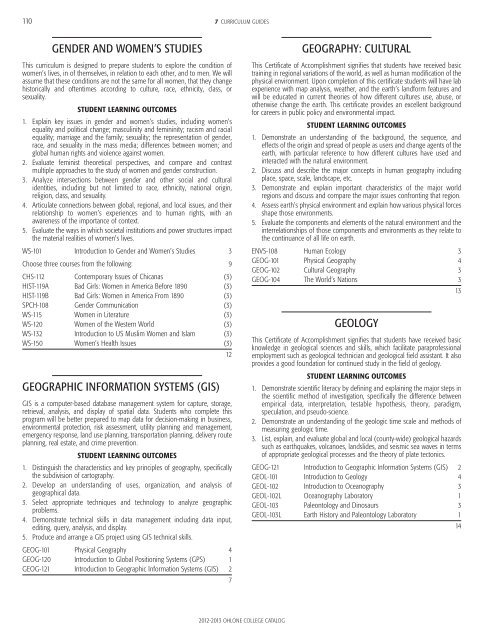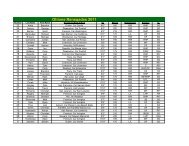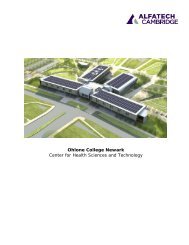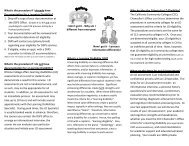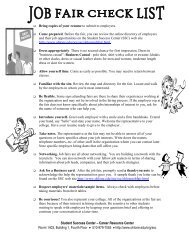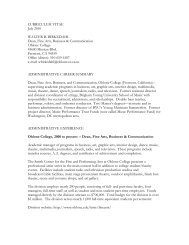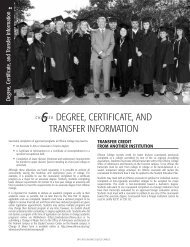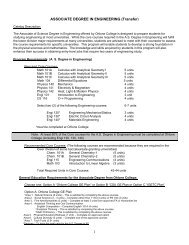2012-2013 Catalog (all pages) - Ohlone College
2012-2013 Catalog (all pages) - Ohlone College
2012-2013 Catalog (all pages) - Ohlone College
You also want an ePaper? Increase the reach of your titles
YUMPU automatically turns print PDFs into web optimized ePapers that Google loves.
110 7 CURRICULUM GUIDES<br />
GENDER AND WOMEN’S STUDIES<br />
This curriculum is designed to prepare students to explore the condition of<br />
women’s lives, in of themselves, in relation to each other, and to men. We will<br />
assume that these conditions are not the same for <strong>all</strong> women, that they change<br />
historic<strong>all</strong>y and oftentimes according to culture, race, ethnicity, class, or<br />
sexuality.<br />
STUDENT LEARNING OUTCOMES<br />
1. Explain key issues in gender and women’s studies, including women’s<br />
equality and political change; masculinity and femininity; racism and racial<br />
equality; marriage and the family; sexuality; the representation of gender,<br />
race, and sexuality in the mass media; differences between women; and<br />
global human rights and violence against women.<br />
2. Evaluate feminist theoretical perspectives, and compare and contrast<br />
multiple approaches to the study of women and gender construction.<br />
3. Analyze intersections between gender and other social and cultural<br />
identities, including but not limited to race, ethnicity, national origin,<br />
religion, class, and sexuality.<br />
4. Articulate connections between global, regional, and local issues, and their<br />
relationship to women’s experiences and to human rights, with an<br />
awareness of the importance of context.<br />
5. Evaluate the ways in which societal institutions and power structures impact<br />
the material realities of women's lives.<br />
WS-101 Introduction to Gender and Women’s Studies 3<br />
Choose three courses from the following: 9<br />
CHS-112 Contemporary Issues of Chicanas (3)<br />
HIST-119A Bad Girls: Women in America Before 1890 (3)<br />
HIST-119B Bad Girls: Women in America From 1890 (3)<br />
SPCH-108 Gender Communication (3)<br />
WS-115 Women in Literature (3)<br />
WS-120 Women of the Western World (3)<br />
WS-132 Introduction to US Muslim Women and Islam (3)<br />
WS-150 Women’s Health Issues (3)<br />
12<br />
GEOGRAPHIC INFORMATION SYSTEMS (GIS)<br />
GIS is a computer-based database management system for capture, storage,<br />
retrieval, analysis, and display of spatial data. Students who complete this<br />
program will be better prepared to map data for decision-making in business,<br />
environmental protection, risk assessment, utility planning and management,<br />
emergency response, land use planning, transportation planning, delivery route<br />
planning, real estate, and crime prevention.<br />
STUDENT LEARNING OUTCOMES<br />
1. Distinguish the characteristics and key principles of geography, specific<strong>all</strong>y<br />
the subdivision of cartography.<br />
2. Develop an understanding of uses, organization, and analysis of<br />
geographical data.<br />
3. Select appropriate techniques and technology to analyze geographic<br />
problems.<br />
4. Demonstrate technical skills in data management including data input,<br />
editing, query, analysis, and display.<br />
5. Produce and arrange a GIS project using GIS technical skills.<br />
GEOG-101 Physical Geography 4<br />
GEOG-120 Introduction to Global Positioning Systems (GPS) 1<br />
GEOG-121 Introduction to Geographic Information Systems (GIS) 2<br />
7<br />
GEOGRAPHY: CULTURAL<br />
This Certificate of Accomplishment signifies that students have received basic<br />
training in regional variations of the world, as well as human modification of the<br />
physical environment. Upon completion of this certificate students will have lab<br />
experience with map analysis, weather, and the earth’s landform features and<br />
will be educated in current theories of how different cultures use, abuse, or<br />
otherwise change the earth. This certificate provides an excellent background<br />
for careers in public policy and environmental impact.<br />
STUDENT LEARNING OUTCOMES<br />
1. Demonstrate an understanding of the background, the sequence, and<br />
effects of the origin and spread of people as users and change agents of the<br />
earth, with particular reference to how different cultures have used and<br />
interacted with the natural environment.<br />
2. Discuss and describe the major concepts in human geography including<br />
place, space, scale, landscape, etc.<br />
3. Demonstrate and explain important characteristics of the major world<br />
regions and discuss and compare the major issues confronting that region.<br />
4. Assess earth’s physical environment and explain how various physical forces<br />
shape those environments.<br />
5. Evaluate the components and elements of the natural environment and the<br />
interrelationships of those components and environments as they relate to<br />
the continuance of <strong>all</strong> life on earth.<br />
ENVS-108 Human Ecology 3<br />
GEOG-101 Physical Geography 4<br />
GEOG-102 Cultural Geography 3<br />
GEOG-104 The World’s Nations 3<br />
13<br />
GEOLOGY<br />
This Certificate of Accomplishment signifies that students have received basic<br />
knowledge in geological sciences and skills, which facilitate paraprofessional<br />
employment such as geological technician and geological field assistant. It also<br />
provides a good foundation for continued study in the field of geology.<br />
STUDENT LEARNING OUTCOMES<br />
1. Demonstrate scientific literacy by defining and explaining the major steps in<br />
the scientific method of investigation, specific<strong>all</strong>y the difference between<br />
empirical data, interpretation, testable hypothesis, theory, paradigm,<br />
speculation, and pseudo-science.<br />
2. Demonstrate an understanding of the geologic time scale and methods of<br />
measuring geologic time.<br />
3. List, explain, and evaluate global and local (county-wide) geological hazards<br />
such as earthquakes, volcanoes, landslides, and seismic sea waves in terms<br />
of appropriate geological processes and the theory of plate tectonics.<br />
GEOG-121 Introduction to Geographic Information Systems (GIS) 2<br />
GEOL-101 Introduction to Geology 4<br />
GEOL-102 Introduction to Oceanography 3<br />
GEOL-102L Oceanography Laboratory 1<br />
GEOL-103 Paleontology and Dinosaurs 3<br />
GEOL-103L Earth History and Paleontology Laboratory 1<br />
14<br />
<strong>2012</strong>-<strong>2013</strong> OHLONE COLLEGE CATALOG


